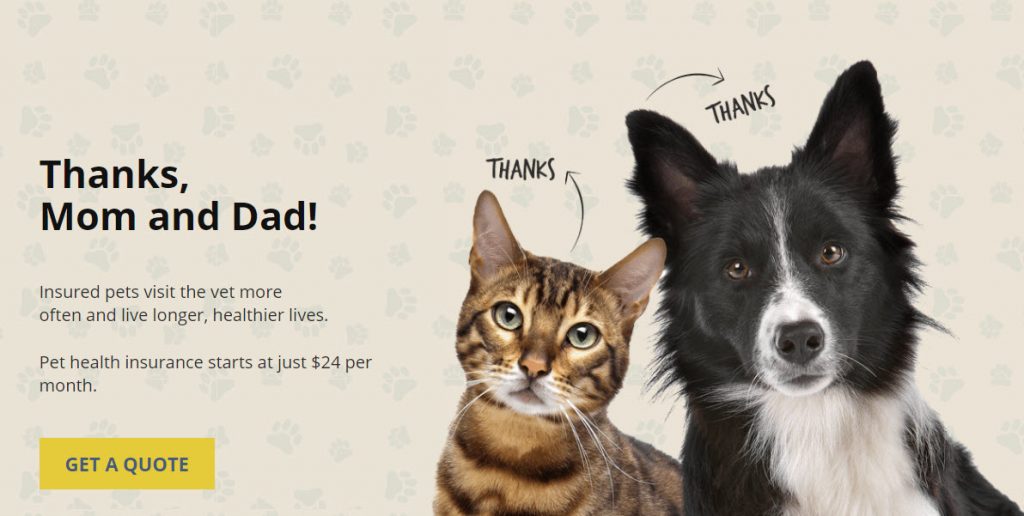Pet Insurance Deductibles

Free Pet Insurance Comparison
Compare Quotes From Top Companies and Save
Secured with SHA-256 Encryption
Dr. Pippa Elliott BVMS, MRCVS
Veterinarian
Dr Pippa Elliott BVMS, MRCVS is a veterinarian with over 30 years of experience in companion animal practice. In 1987 she graduated from the University of Glasgow, with a degree in veterinary medicine and surgery. She works at Blythwood Vets and the People’s Dispensary for Sick Animals (PDSA). Pippa is an advocate of Fear-Free Practice, an animal addict, and a veterinary writer. She is also w...
Veterinarian
UPDATED: Feb 3, 2025
Pet Insurance U receives compensation from the third parties included on this site. This includes payment for clicks from our site to insurance providers’ sites and quote requests generated. Our rankings and reviews are not affected by payments from the insurance companies. The compensation we receive allows the site to be free and regularly updated. Our goal is to review every pet insurance provider, but not all companies are listed on the site.
And many of the companies we review do not pay us anything. We simply rate, compare and review their plan because we feel it will be valuable to you. Our reviews are guaranteed to be unbiased, professional and advertising compensation does not influence rankings.
We are a free online resource for anyone interested in learning more about pet insurance. Our goal is to be an objective, third-party resource for everything pet insurance related. We update our site regularly, and all content is reviewed by pet insurance experts.
UPDATED: Feb 3, 2025
Pet Insurance U receives compensation from the third parties included on this site. This includes payment for clicks from our site to insurance providers’ sites and quote requests generated. Our rankings and reviews are not affected by payments from the insurance companies. The compensation we receive allows the site to be free and regularly updated. Our goal is to review every pet insurance provider, but not all companies are listed on the site.
And many of the companies we review do not pay us anything. We simply rate, compare and review their plan because we feel it will be valuable to you. Our reviews are guaranteed to be unbiased, professional and advertising compensation does not influence rankings.
On This Page
There are many different variables to consider when you first enroll in a pet insurance plan.
Pet insurance deductibles are just one important part of the equation.
Each plan has different deductible amounts and different types of deductibles that can affect the monthly premium.
Table of Contents:
Need Pet Insurance?
FACT: Pet insurance pays up to 90% of vet bills when your pet is sick or injured!
How Do Pet Insurance Deductibles Work?
Deductibles are essentially the amount you pay out of pocket before the insurance company pays any of your bills.
They are similar to a deductible in our own health insurance policies.
Pet insurance deductibles can save you money because you can elect to have higher deductibles and pay lower premiums.
This is the best bet for pet owners who don’t anticipate any health issues for your pet in the upcoming year.
Enter your ZIP code below to view companies that have cheap pet insurance rates.
Secured with SHA-256 Encryption
Deductible Ranges

When you enroll in a pet insurance policy, you first decide which deductible amount that you want to pay.
Deductibles can start as low as $50 and go as high as $1,500.
Most plans, like Healthy Paws and Embrace, give you a wide range of deductible choices so you can choose and budget accordingly.
For example, Healthy Paws offers deductibles of:
- $100
- $250
- $500
- $750
Deductible Types
There are two main types of deductibles:
1 – Annual Deductibles
The annual deductible is a set amount that you pay each new policy year before you receive any money back from your insurance provider.
If you have an annual deductible of $500, then you will not receive any money from your insurance provider until you have a total of at least $500.01 in claims.
Once you hit that number, you will then be reimbursed based on the percentage amount that you had chosen.
For example, if you need to take your dog to the vet and the bill is $750 and you chose the $500 deductible, then your insurance company would pay you back $250 minus the co-pay that you choose.
Some companies only offer an annual deductible because it is easier for everyone involved. One payment and you are done for the year.
These deductibles are the most popular and generally the most preferred.
2 – Incident Deductibles
A per-incident deductible is a deductible that needs to be reached every time you take your cat or dog to the vet for a new condition or sickness.
For example, an episode of indigestion would count as one condition and a wound on your dog’s paw would count as another. Each deductible would reset for every incident.
For instance, it is not uncommon for your dog to go to the vet multiple times each year.
And if you choose a $150.00 per-incident deductible, you could easily pay it three times if the conditions are not related.
For example, suppose you decided that a $200 incident deductible worked for you.
Related: 10 Things You Must Know Before You Buy Pet Insurance
And then your dog has an illness that costs $400 to treat and a broken set of ribs that could easily cost you $1,200, then your insurance provider would pay $1,200.
You would have to pay $200 for each condition and treatment and then the pet insurance company would pay the rest.
Therefore, they would pay $200 for the illness and $1,000 for the broken ribs.
If you had chosen a $200 annual deductible, then you would only pay it the first time your dog got sick and your deductible is met for any other sickness or condition that occurs.
Incident Deductibles are also broken down into annual and lifetime:
Per Condition Annual
Similar to an annual deductible, these reset each year.
Per Condition Lifetime
This deductible is paid once per condition for the duration of the pets’ life.
This can be a good choice for a dog or cat that suffers from a life-long or chronic disease like diabetes or cancer.
However, each new illness or condition will still need another deductible.
You can see how an annual deductible is really the preferred choice because you only pay it once a year and not per condition or illness.
Real Cost Savings from PetFirst Clients

Luna
PetFirst saved his parents
$6,712
A happy energetic Luna one morning couldn’t hold her food down. After months of multiple costly vet visits to specialists and an endoscopy, the problem was discovered and fixed. Luna put 22 pounds back on in no time and her parents were grateful for having PetFirst by their side to pay the bills.
What Are The Advantages Of A Higher Or Lower Deductible?
With a lower deductible amount, you will have a higher premium but you can then reach the reimbursement level sooner and could save sooner on your bills.
With a higher deductible, you will have a lower monthly premium and save more each month but it will take more time to reach the reimbursement.
Enter your ZIP code below to view companies that have cheap pet insurance rates.
Secured with SHA-256 Encryption
What Is The Best Deductible To Choose?
The deductible that is the right one for you really has to do with your budget and your pet’s condition.
Of course, the best choice is an amount that you know you feel comfortable paying.
What Is A Co-Pay?
The co-pay is the amount that you need to pay to the insurance company based on the reimbursement level you chose and after the deductible has been met.
Typical reimbursements are 65 to 90% meaning the co-pay would be 10% to 35%.
Based on the example above, you have already reached the $500 deductible of your $750 bill and the remaining balance is $250.
If you had chosen a co-payment of 20%, your insurer would reimburse you $200 (80% of the $250 balance).

Other Helpful Tips
An annual deductible is usually the best way to go if you think your pet will be seeing the vet for a couple of different incidents or conditions.
If you anticipate that your dog or cat is healthy and might only see the vet for an annual visit, the per-incident deductible might be the better choice.
Would you prefer to pay a lesser amount when your pet needs treatment? Then a deductible on the lower end of the range is preferable.
Or if a lower monthly premium is preferable, then a higher deductible is the better option.
The deductible is only part of the equation when you sign up for a new policy. If you can find out what your dog or cat will need in the next few years, that can be helpful in making a decision.
Get quotes from various pet insurance providers and make sure you know how it works before you make a change. Have a set of questions ready and think about how much you can afford to pay each month.
If you need a good place to start, make sure to look at our top pet insurance companies.
It will give you some good choices of companies as well as explain some other things to look out for a new pet insurance policy.
Other articles you may find helpful:
Is Exotic Pet Insurance Necessary?
The Best Pet Insurance By State
Fun Facts, Dog FAQ, And Unsolicited Dog Advice
5 Training Commands to Save Your Dog’s Life
The Ultimate Guide to Safe Foods for Dogs
Pet insurance is similar to other insurances but does have some major differences as compared to your health insurance. Below you will find a definitive list of frequently asked pet insurance questions to help in your decision.
Types of Pet Insurance Coverage
Comprehensive Pet Insurance Explained
Insurance vs. Wellness Pet Insurance Plans
Is Pet Dental Insurance Worth the Extra Cost
Best Pet Insurance Plans with Shortest Waiting Periods
Pet Insurance Coverage Exclusions and Limits
Pet Insurance Benefit Limits Explained
How to Make a Claim on your Pet Insurance
Is my Pet too Old for Pet Insurance Coverage
Top Reasons to Purchase Pet Insurance
How much does Pet Insurance Cost
Pet Insurance for Multiple Pets
Pet Insurance that Covers Spaying and Neutering
Does Pet Insurance Cover Shots
Pet Insurance with Pre-Existing Conditions
Enter your ZIP code below to view companies that have cheap pet insurance rates.
Secured with SHA-256 Encryption
Frequently Asked Questions
What is a pet insurance deductible?
A deductible in pet insurance is the amount you must pay out of pocket before the insurance company starts covering any of your pet’s medical expenses. It’s similar to the deductible in human health insurance policies.
How do pet insurance deductibles work?
Pet insurance deductibles work by requiring you to pay a set amount (deductible) before the insurance company begins covering expenses. There are two main types: annual deductibles, which reset each policy year, and incident deductibles, which apply to each new condition or sickness.
What are the deductible ranges for pet insurance?
Deductibles for pet insurance can range from as low as $50 to as high as $1,500. Most plans offer a variety of deductible choices, allowing you to select based on your budget and preferences.
What are the advantages of a higher or lower deductible?
Choosing a lower deductible results in a higher monthly premium but faster reimbursement. Opting for a higher deductible lowers your monthly premium but delays reaching the reimbursement level. The choice depends on your budget and your pet’s health.
How to choose the best deductible?
The best deductible for you depends on your budget and your pet’s health condition. It’s crucial to choose an amount that you’re comfortable paying. Consider factors like your pet’s anticipated medical needs and your financial situation.
What is a co-pay in pet insurance?
A co-pay is the amount you pay to the insurance company based on the reimbursement level you chose and after the deductible has been met. Typical reimbursements range from 65% to 90%, making the co-pay 10% to 35%.
What is the best type of deductible – annual or incident?
An annual deductible is generally preferred as it resets once per policy year. Incident deductibles apply to each new condition, potentially leading to multiple deductible payments in a single year.
Are there different types of incident deductibles?
Yes, incident deductibles can be per condition annual (reset each year) or per condition lifetime (paid once per condition for the pet’s entire life). Annual deductibles are often recommended for their simplicity and cost-effectiveness.
How do I save on pet insurance costs?
To save on pet insurance costs, consider factors such as your pet’s health, anticipated medical needs, and your budget. Getting quotes from various providers and understanding the terms of each policy can help you make an informed decision.
Is pet insurance worth it?
Pet insurance can be worth it, especially if you anticipate regular vet visits or have a pet with chronic conditions. Assess your pet’s needs, your financial situation, and compare different pet insurance providers to determine if it’s a worthwhile investment for you.
Enter your ZIP code below to view companies that have cheap pet insurance rates.
Secured with SHA-256 Encryption
Dr. Pippa Elliott BVMS, MRCVS
Veterinarian
Dr Pippa Elliott BVMS, MRCVS is a veterinarian with over 30 years of experience in companion animal practice. In 1987 she graduated from the University of Glasgow, with a degree in veterinary medicine and surgery. She works at Blythwood Vets and the People’s Dispensary for Sick Animals (PDSA). Pippa is an advocate of Fear-Free Practice, an animal addict, and a veterinary writer. She is also w...
Veterinarian
We are a free online resource for anyone interested in learning more about pet insurance. Our goal is to be an objective, third-party resource for everything pet insurance related. We update our site regularly, and all content is reviewed by pet insurance experts.
